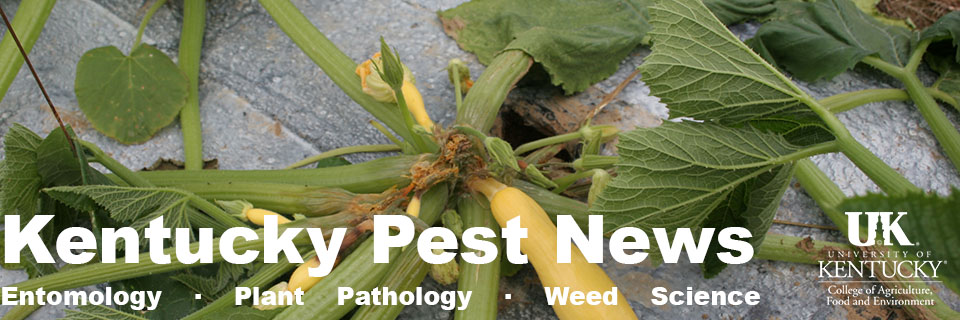Hemp (Cannabis sativa) is grown both outdoors and in greenhouses. Outdoor-grown hemp is susceptible to infection by leaf spot fungi that affect other crops and nearby plants, especially during periods of extensive rain or high humidity. There are three primary leaf spot diseases that affect hemp in Kentucky: Cercospora leaf spot, Bipolaris leaf spot (also called hemp leaf spot), and Septoria leaf spot. Septoria leaf spot is the most commonly reported of the leaf spot diseases.
Symptoms
Septoria leaf spot (Figure 1) causes leaf spotting that can result in leaf loss and reduction of photosynthesis. Under extreme conditions, plants can lose 50% to 90% of leaves. If disease becomes severe early in the season, plant stunting and loss of vigor is possible. Plant death can occur under extreme conditions.

Disease symptoms begin in lower leaves and within the inner canopy where leaf wetness and high humidity occur. Disease begins as small irregularly shaped spots with bright yellow margins. Spots expand to about ¼ inch in diameter and appear brown with a prominent yellow halo. As spots enlarge, brown areas become more irregular and develop gray to white centers. Yellow halos expand outward from spots. Advanced symptoms include coalescence of yellow areas and/or coalescence of brown spots. Entire leaves rapidly become yellow and drop from plants.
Causal Agent
The fungus that causes Septoria leaf spot is Septoria cannabis. In general, Septoria spp. infect specific hosts or a specific group of hosts. For example, Septoria lycopersici causes disease on tomato and other solanaceous plants, and Septoria tritici blotch of wheat affects only wheat and grass hosts. Neither of these diseases are caused by the same species that causes disease in hemp.
Septoria leaf spot spreads by spores called conidia. Infective conidia develop within capsule-like structures called pycnidia. Pycnidia appear as dark specks that resemble black pepper flakes in centers of spots; they contain large numbers of conidia. When excess moisture is present, conidia are released from pycnidia in a curling, oozing formation. Conidia move short distances via rain splash and long distances by wind-driven rain. Each conidium is capable of creating a new infection, and these new infections develop into leaf spots within 7 to10 days.
When excess moisture or high humidity is available, fungal life cycles are shorter, and larger numbers of spores are produced. Thus, as canopies become denser, humidity increases, and disease becomes more severe. During rainy summers, disease can spread rapidly through fields.
Septoria species can overwinter in fields on infected plants or in debris. Pycnidia serve as survival structures, protecting conidia from extreme environmental conditions such as desiccation. Under cool conditions with low relative humidity, pycnidia may remain viable for up to 9 months in debris. In contrast, pycnidial survival decreases dramatically in hot weather. When buried in soil (i.e. tilling), pycnidia survive less than one month. Septoria cannabis has been confirmed to overwinter in hemp debris in Kentucky.
Although alternative hosts have not been identified for Septoria cannabis, it is likely that weeds or another similar “green bridge” is responsible for survival from one growing season to the next. As information on host range becomes available, management recommendations will be updated.
Additional Resources
- Kentucky Hemp Disease Website (Link)
By Nicole Gauthier, Plant Pathology Extension Specialist
